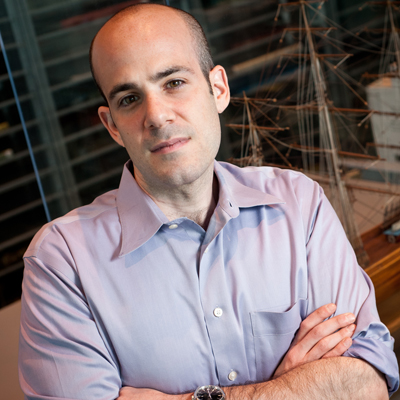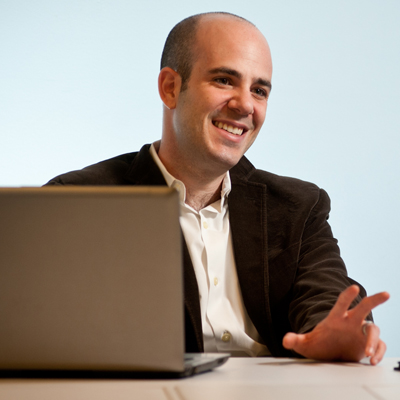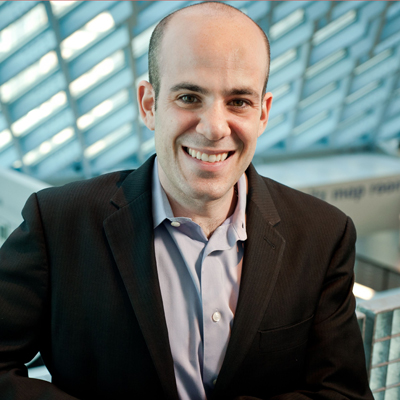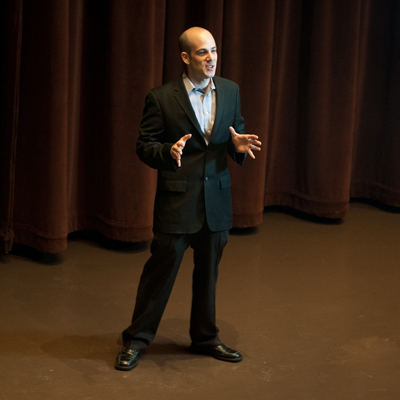1. How would you describe your typical working day?
An exercise in controlled chaos. Wake up at 4AM, work on books or management consulting projects for international clients, get status reports from partners at each of our business holdings, then negotiate with global strategic partners. During breakfast, engage in more complex negotiations with wife and child. Spend next several hours managing day-to-day operations for corporate training firm, management consulting arm, and software/media publishing labels. Fourteen hours later, after engaging in random mix of C-level advisory work, strategic planning, TV/radio hits, general management services, and live speaking appearances, stop and try to remember what it was like to sleep onetime.

2. How the future will affect us is a question often asked and your views are always valuable, so what do you see in store at the moment?
Massive shifts in communications, technology and information are sweeping the globe, prompting seismic changes in how we both process data and interact with others. (Looking at today’s customer alone, we’ve got entire generations being trained to expect hyper-intuitive, flexible, instantly engaging, highly-social and intensely-personalized experiences of every kind on-demand.) But while topics and trends such as big data, mobility, virtualization and connected devices continue to transform our world, how the future impacts us isn’t just defined by these specific advancements so much as the way in which we choose react to them. Which is to say that change is hitting us harder, faster, from more angles and more frequently than ever before – change that brings both challenges and opportunities, as both cultural and customer needs and expectations constantly shift. How the future impacts us is ultimately defined by our openness to change, flexibility and willingness to learn and adapt – factors that any individual or organization has the power to control, and use to steer the future towards more positive outcomes.
3. Today’s business landscape is constantly changing. What advice would you give organizations hoping to stay ahead of the curve?
Remember that there are two types of innovation: Incremental and breakthrough, or – in everyday terms – evolutionary or revolutionary. Sometimes, the simplest ideas or inventions are the best: You minimize risk and maximize potential gains when you can give your tires a realignment (a.k.a. repositioning) instead of having to reinvent the entire wheel (a much lengthier, trickier and expensive process). However, both should be pursued in tandem – just like managing a financial portfolio, making a series of small and smart wagers combined with larger bets can pay big in the aggregate. You’ve also got to balance promise with practicality, and bet on projects, teams and individuals whose ambition matches their ability to execute. Likewise, innovators must further understand the importance of embracing failure, so long as you do so smartly, strategically, fast, cost-affordably and with an eye towards informing future efforts. Think of it like education: As with academic learning programs, we have the power to control how extensive, expensive and effective these efforts will ultimately be. Remember that success seldom happens overnight, and making mistakes is how we learn. Our ability to learn from and bounce back from adversity is what defines true success. The key to getting ahead as an individual or enterprise today isn’t to be smarter, stronger or more of a perfectionist. Rather, it’s to be more resilient – able to problem-solve dynamically, adapt, and constantly course-correct as needed.

4. In today’s fast-moving market, everyone’s trying to get one step ahead. How can enterprises and individuals stay ahead of the curve?
You don’t have to be psychic to see the future coming, or even exceptionally bright or talented to put it to work for your benefit. Rather, you just have to keep your eyes and ears open, be proactive about planning for change, and be flexible about rolling with the punches that it brings. Pop culture fetes entrepreneurs like Steve Jobs, Mark Cuban and Mark Zuckerberg and game-changing startups such as Spotify and Instagram as “mavericks” that love to take risks and pursue game-changing breakthroughs. However, look at these individuals and organizations more closely though, and you’ll find they’re often anything but. They study the playing field before them, weigh the odds, and only wager when the odds favor them winning. The same strategy they use to succeed in business is one you can use on both an enterprise or individual level too: Look for gaps in the marketplace where competitors are few/weak, there’s a sizable audience (niche or otherwise), and you know the project/organization/individual in question has a clear competitive advantage (unique product, specific skills/features/benefits, etc.) that competitors will find hard to replicate. If it can be done better, faster or cheaper, rest assured it will. If it blends in with rivals, rest assured it will never stand out. The key to creating competitive advantage is finding something clearly unique, clearly different, and clearly practical and easy to differentiate with regard to what you or your organization have to offer that it creates such singular value for the customer that it’s impossible or painfully difficult to ignore. It’s about using basic strategy outlined in The Art of War – know the battlefield, strike where your enemy isn’t, et al – and making the product/project/organization/etc impossible to overlook or replace.
5. You inspire and motivate audiences, but where do you get your energy and inspiration from?
Audiences themselves: An endless source of inspiration and education, and infinite wellspring of insight and motivation. Here, we consider ourselves eternal students, and works-in-progress. That means that every minute of every day is a teachable moment, and every individual and enterprise we work with isn’t just a client, but also partner, peer and mentor. We learn every bit as much from them as they do from us, and once you start learning, you start to see how little actions and course-corrections actively made day in and out can make vast changes and improvements in your life and business. And once you see that, well… Learning, sharing and growth become a 24/7 habit, one that quickly spirals into an upward cycle that presents myriad ways to give back to your company, your customers, and your community. Once you get a sense of the big changes that little choices can make happen, what time is worth, and how powerful the actions and decisions you pursue can be, you’ll never think about wasting time, effort or energy again. There’s so very, very much that all of us can do to create positive change, and do with a simple change in mindset, that it almost becomes anathema to you to keep quiet and sit still.
6. You’ve written a number of books – and have a new publication out. Please give us a little insight…
We’ve written over a dozen books, workbooks and training guides to diverse topics ranging from leadership to change management, consumer trends, social media strategy and strategic innovation, the latest being Becoming Essential, which contains everything you need to know to successfully lead and succeed in uncertain and risky environments. In a world where everything has changed for businesses, brands and working professionals, it presents a complete guide to successfully leading, managing and driving positive change and growth in times of great upheaval. Designed for both organizations and individuals alike, it outlines a new formula for achieving success on both a professional and personal level, and how to build competitive advantage by learning how to spot and seize upon opportunities before competitors can react. Consider it a complete guide to strategic innovation on every level, both from an enterprise and executive standpoint.
7. Helping people manage change is one of your many talents. Why is change so challenging?
Humans are creatures of habit: Our brains and bodies are actually hardwired to operate more efficiently when they go on auto-pilot. And businesses are built to optimize systems that most successfully leverage predictable environments and formulas. So when change happens, it occurs out of the preset boundaries with which we’re often comfortable, or operations are designed to function – an often jarring adjustment. The trick to being better at change is to never get into a comfortable groove, and constantly be planning for the bad times in good, stretching your capabilities, and expanding comfort zones, as well as deploying new strategies and solutions, adapting and course-correcting as you go. Change can and will happen: The question is whether you’re prepared and willing to surf its waves, or would prefer to let it passively wash over you.

8. You’re a ‘jack of all trades’….but how do you see yourself?
Student. Friend. Father. Teacher. Mentor. I’m an eager pupil. A startup. A work in progress. And ultimately, I’m in the business of three things: Education, elevation and empowerment. Nowhere in the job description will you find titles like manager, marketer or business development pro. Rather, the description is simply “make it right, and make things better.” Our job is to help others (and help them learn to help themselves), which requires constantly having to adapt our strategies, mindsets and solutions to most effectively to do so given the context. And what that means is, like everyone from major corporations to working professionals are already doing on a constant basis, we too must constantly go, try, see, do and learn as we go.
9. Our world is constantly being affected by new technologies. Ultimately, do the benefits outweigh the disadvantages?
Absolutely – technology presents the world’s most powerful tool for boosting productivity, heightening education and creating opportunity by breaking down walls. But it bears remembering that technology is just a tool – an enabler, if you will. Equally important as using the right tool for the job is knowing how, when and where to use it to best effect.

10. Where do you get your greatest satisfaction? Entrepreneurship, trend-spotting, strategic advising, looking at innovation, playing an instrument… or is there something you haven’t told us?
Nothing quite so fancy, alas. I get it from helping others, and helping them to make a difference. Although we write books on topics from trend-spotting and marketing strategy to business etiquette, high-tech parenting and entrepreneurship, I’ll let you in on a secret. There’s a running theme that unites each and every one: Rather than simply tell stories, we teach readers how to write their own. There’s no “it’s just business,” anymore. There’s just life, as author Seth Godin argues, and we love every moment – a moment that can be used to create positive change for all. Also: I take great pleasure spending time with small children (the happiest, and surprisingly often wisest individuals you’ll ever meet), and learning new jokes, games and riddles – as a side-effect, have become something of a toy and video game expert. All work and no play, one supposes…
11. Sir Richard Branson said people should refer to you if they want to know about business. Quite a compliment… do tell us more…
Perhaps more so than any other entrepreneur, Sir Richard embodies the spirit of change and innovation. He never sits still, never stops learning, and never ceases to work towards achieving his goals, no matter how seemingly novel or impossible – even if that means having to stumble and pick himself back up again. He changes with the spirit of the times, and, in fact, often makes them change with him. But, most importantly, he keeps a sense of positivity and humor about him as he goes, the most important attributes necessary for success of all.
12. We’re all looking to work more efficiently and to seek new opportunities – any advice?
Don’t just bet on a winning idea: Bet on a team or individual that you believes has the skill, experience and know-how it takes to bring it to life. Concepts are a dime a dozen – execution is where winners excel. Look for a team or individual with the experience, track record, talent and resources to not only conceive and construct the project, but also pull it off from an overall marketing, PR and business standpoint. Going from dream to reality is a difficult process: You need to be certain the horse you’re backing can stay the course, let alone cross the finish line first.
13. OK, so I’ve got some good ideas that I can see might be worth pursuing. What’s next?
Cover your assets: The same way you spread risk amongst a financial portfolio and hope a few wins pay off in the long-run, spread strategic investments across a portfolio of options – you know what they say about putting your eggs in one basket. High-return investments are often high-risk – but you can still remain conservative and make a sizable return by playing it safe and spreading your wagers across a variety of gambles, some of which may not pay as well, but offer better odds of success. Remember: You don’t have to hit grand slams on every try at bat – base hits can steadily add up to create a winning game.

